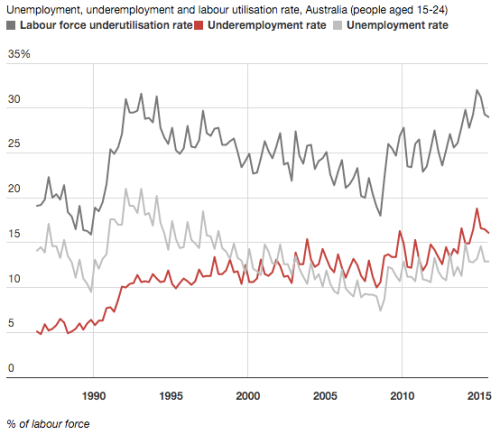Youth employment 'crisis' more about job quality
Do we have an immediate youth unemployment 'crisis' in Australia? Or is it more of a slow burn? In this post, Dr Iain Campbell of RMIT University provides some insights. This post originally appeared on The Conversation.
Calls for action on youth unemployment this year have typically been accompanied by references to “alarming” data from the Australian Bureau of Statistics (ABS).
Figures for early 2015, for example, point to more than 300,000 unemployed youth (aged 15-24), including more than 60,000 who were long-term unemployed, and a youth unemployment rate that had jumped to over 15%. Though these figures have since fallen back a little, concern about a “crisis” of youth unemployment remains high, with two conferences on youth employment planned before year-end.
Like generals still fighting the last war, most commentators seem trapped in the recession of the early 1990s. They overlook at least two long-term developments that cast a different light on the standard ABS data on youth unemployment.
The first development is the increased participation of youth in full-time education, often combined with participation in a part-time job. The percentage of the total youth cohort made up of full-time students has risen steadily from around 30% in the mid-1980s to 53% in August 2015 (ABS). This growth is in turn accompanied by an increased propensity to take up a part-time job; in the mid-1980s one in four full-time students was counted as employed, but now the figure hovers around 40%. The trends are familiar, but the implications for the unemployment count are rarely noticed.
Just as some full-time students are counted as employed, others can be counted as unemployed. In fact, if we disaggregate the data, we see that in early 2015 over half of all unemployed youth were full-time students. This is a recent phenomenon, not evident in earlier economic downturns and completely missed in most labour market commentary.
There is nothing wrong with including in the unemployment count those full-time students who are not employed but want a part-time job (and are available and actively looking for such a job); it conforms to the way labour force statistics are constructed and reflects the aim of measuring excess labour supply in the economy.
Confusion only arises if we interpret the youth unemployment figures not as a measure of “excess labour supply” but as an index of disadvantage and misery. Here we have to be careful. Full-time students do not match the conventional stereotype of the young unemployed; they are able to evade much of the disadvantage associated with unemployment, especially that suffered by the long-term unemployed. Bundling them up with other young unemployed persons without due attention to the different social and economic circumstances risks exaggerating the impact of youth unemployment.
The second development is the increased importance in youth labour markets of part-time jobs that do not offer enough hours to meet needs – what is called “(time-related) underemployment”. This has become a prominent feature of Australian labour markets, affecting the lives of both non-students and students.
The chart below presents the startling story of unemployment and underemployment rates (together with the sum of the two, which is known as the labour force underutilisation rate) for youth over the past three decades. It shows the steady rise in the underemployment rate to a clear position of dominance in the statistics. In August 2015, the youth unemployment rate may have reached 12.9%, but this was well below the youth underemployment rate of 16.1%.
Measuring excess labour supply
The data in the chart have radical implications that tend to be overlooked in the analysis of youth unemployment. The figures on labour force underutilisation indicate that the level of difficulty for young people in accessing adequate hours of paid work is indeed high, similar today to what it was in the early 1990s. But whereas in the earlier recession the problem was largely one of unemployment, today the problem is split between unemployment and underemployment, with most of the weight falling on the latter. In short, the challenge today is less to do with the quantity of jobs and more to do with the quality of the jobs available for young people.
Quality not quantity
Underemployment measures discontent with the number of hours in the current part-time job (and by implication with the income in the job), but it can be taken as the tip of the iceberg for a more general problem of poor quality or precarious jobs, which push young people in and out of work and offer little prospect of long-term skill development and income security.
The current discussion in Australia, focused just on youth unemployment, fails to explain why there are so many poor quality, often casualised jobs. It also contributes little in terms of policy. Indeed, what is striking about the discussion is the poverty and predictability of the policy proposals, which stretch from the conventional ideas of labour market deregulation popular amongst employer groups to a gamut of measures aimed at improving the “employability” of young people. None of these measures offer an adequate response to the substantial problems revealed in ABS data; most threaten to make things substantially worse for young people.
Is there a “crisis” of youth unemployment? The data summarised here tend to puncture this extravagant claim (though they confirm a modest problem with a small group of long-term unemployed). Instead they suggest we need to focus on a more slow-burning crisis for youth – a challenge for the new Turnbull ministers.
Iain Campbell, Senior Research Fellow at the Centre for Applied Social Research, RMIT University
This article was originally published on The Conversation. Read the original article.


